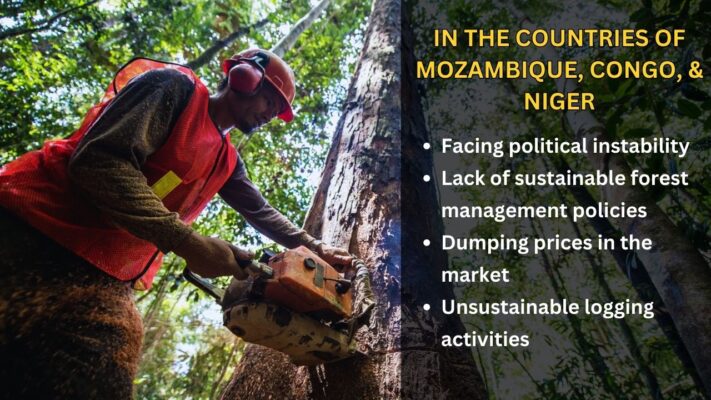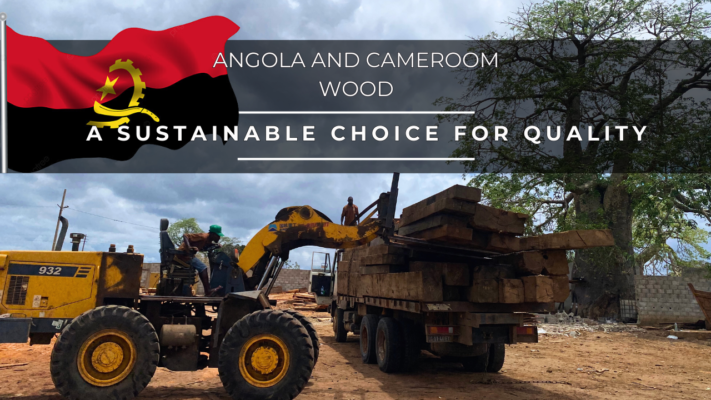Why is wood from Mozambique, Congo, and Niger often 20-30% or even more cheaper than wood of the same type from Angola and Cameroon? This is a common question for many customers at K-TIMBER when buying wood in Africa. As a long-term African wood supplier, I think I have the responsibility to answer this question.
Perhaps many people will guess the answer: You get what you pay for! But if we only answer like that, it is not very convincing, right? This article is written from an objective perspective and will explain in detail why there is a difference in price and quality of wood in Mozambique, Congo & Niger when compared to Angola & Cameroon.

Table of Contents
Differences in geographical factors affect wood quality
Surely you all know that the quality of wood used in furniture and construction varies greatly depending on its origin. Geographical factors such as climate, location, and soil composition play an important role in shaping the characteristics of wood.
First, location is one of the most significant factors affecting wood quality. Trees from different regions exhibit contrasting characteristics. Angola and Cameroon are located in the subtropical region, with a very mild climate with two distinct seasons and an average annual rainfall ranging from 500 to 2,500 mm, which makes the trees grow faster, be healthier, and have a higher durability. Therefore, the wood of Angola and Cameroon always retains its luster and beautiful color even when stored in the warehouse for a long time.

On the contrary, with Mozambique, Congo, and Niger, although they have a faster growth rate due to their proximity to the Southern Hemisphere and more moderate conditions, the heavy rain causes the trees to grow excessively, affecting the internal structure of the wood, and thus the quality is also affected. As a forestry export expert for many years, I have seen that wood in these countries quickly fades and loses its luster within 2-4 years.
In addition, the abundant rainfall and moderate temperatures in Mozambique, Congo, and Niger make the growth rate of the trees faster, while also reducing the density of the wood and its long-term durability.
For example, Doussie wood from Angola and Cameroon typically has an average density of about 0.75 g/cm3 while wood from Mozambique has an average density of about 0.65 g/cm3. This is a fairly low density, making Mozambique wood susceptible to warping, cracking and rotting.
In addition, high water absorption also makes wood from Mozambique vulnerable to termite attack. Therefore, when using wood from this area, it is necessary to carefully treat it with specialized drying and chemical impregnation methods to ensure quality and durability.
In my objective assessment, although Mozambique wood may be readily available and inexpensive, its poor quality makes it unsuitable for demanding projects. On the other hand, the beauty and long-term durability of Angola and Cameroon wood justify its higher price for craftsmen seeking superior quality.
Differences in wood processing and preservation
Another factor that I think also affects the durability, stability, and lifespan of wood is the processing and preservation techniques used.
In Mozambique, Congo, and Niger, cost-cutting measures are often prioritized over quality. Wood is dried to a moisture content of 25-35% in just one week, compared to the standard two weeks as stipulated by our regulations. This rapid drying process, although it minimizes drying time and costs, affects the stability of the wood, leading to warping, cracking, and breakage over time.

During a business trip to Mozambique, I was truly surprised to see that most sawmills in these areas do not have large saws. Instead, they use hand tools with dull blades. This leads to uneven cuts, which affect the size of the wood and reduce the accuracy of cutting wood to customer specifications. In addition, they often export mainly in the form of semi-processed logs, such as square and round logs, which often do not meet the quality and size requirements.
After many years in the industry, I have met hundreds of customers from many countries around the world, including Vietnam. I have noticed that Vietnam is a market where Mozambique and Congo wood is widely available. Many importers and carpenters come to me and say, “Unlike wood from Angola and Cameroon, which can be used immediately after purchase, wood from Mozambique, Congo, and Niger needs an additional 1-2 months of air drying to reach a stable moisture content. This delays the use of wood and adds to the cost of our entire process.”
On the contrary, in Angola and Cameroon, quality is prioritized over fast processing. They take advantage of longer and more tightly controlled drying times, ensuring that the wood reaches a stable moisture content without affecting the structure of the wood. In addition, with advanced sawing technology and precise cutting ratios down to the millimeter, they easily meet international standards for size and quality. Therefore, although wood from Angola and Cameroon is more expensive, it also means better durability, color, and wood grain.
Government policy
Finally, I would like to consider the government factor in these countries. While geographical factors and processing techniques play an important role in shaping wood quality, the underlying government policies in timber-producing countries can have a significant impact on the market, commercial ethics, and purchase decisions.
In the countries of Mozambique, Congo, & Niger, they often face political instability and lack of sustainable forest management policies from the government on timber management. This creates an unorganized exploitation environment and inconsistent regulations, leading to fluctuations in prices and supply. Such fluctuations can have a negative impact on the quality and reliability of timber trading.

Moreover, these policies have also inadvertently contributed to market dumping. The influx of cheap, low-quality wood on the market has had a negative impact on competition between suppliers. In addition, loose regulations can lead to environmental exploitation and unsustainable timber exploitation activities.
On the contrary, Angola and Cameroon implement policies that prioritize both group interests and good government management. Specifically, these countries have established regulations to ensure sustainable forest management and responsible timber exploitation. The government policies in these areas often consider the needs and interests of local communities and indigenous people who live off the forest for their livelihood.
Among them, K-TIMBER is proud to be one of the leading companies issued with full forest exploitation documents such as CITIES, Forestry Stewardship Council™ (FSC™), International Finance Corporation Performance Standards (IFC-PS) and International Labor Organization (ILO) standards among others.

Therefore, purchasing from countries such as Angola and Cameroon, although the initial cost is higher, it contributes to creating a more sustainable and ethical wood industry in the long run.
In conclusion
Although the appeal of low prices is undeniable, especially in today’s economic climate, sacrificing quality for cost can quickly backfire when it comes to wood. A few months ago, we had a customer from Turkey named Mark contact us to inquire about importing 3 containers of Iroko wood, and he shared a story about his experience buying wood from Mozambique. Initially attracted by the seemingly “unbeatable” contracts offered by wood suppliers in Mozambique, Mark chose to import 2 containers of Doussie wood for his furniture manufacturing business. The savings were significant, leaving him feeling incredibly optimistic about increased profits and competitive advantage. However, this optimism soon turned to disappointment.

The Mozambique wood initially appeared to be quite good but began to exhibit concerning flaws within a few months. Warping, cracking, and discoloration became common, leading to unusable products and disappointed customers. The seemingly “cheap” wood ultimately ended up costing Mark dearly, not only in terms of wasted materials and lost production time, but also in terms of damage to his reputation and customer trust.
So remember: buying cheap wood may feel like a win in the short term, but it can quickly turn into a costly loss. Don’t let greed cloud your judgment. Choose quality, choose sustainability, choose Angola and Cameroon. By making wise choices, we can contribute to a more ethical and sustainable future for the wood industry, while ensuring that our investments, both financial and environmental, truly stand the test of time.





![[K-Timber] Blog Post Boder](https://k-timbers.com/wp-content/uploads/2024/06/K-Timber-Blog-Post-Boder.jpg)




